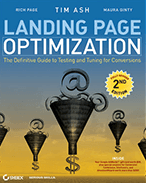Revealed: When Bounce Rate Sucks.
Last updated | Bounce rate is usually one of the most powerful metrics to monitor for pages on your website. And when I mean bounce rate, I mean the percentage of people who arrive on a page, and leave immediately (or as Avinash Kaushik so nicely put it – ‘they came to your website and puked’). Its a great way of identifying which pages to improve and optimize.
Bounce rate is usually one of the most powerful metrics to monitor for pages on your website. And when I mean bounce rate, I mean the percentage of people who arrive on a page, and leave immediately (or as Avinash Kaushik so nicely put it – ‘they came to your website and puked’). Its a great way of identifying which pages to improve and optimize.
BUT if you take a closer look at how bounce rate is calculated, you will see it is actually sometimes misleading for certain types of pages. Yep.
Even bounce rate can suck sometimes. Let me explain why…
The two major ingredients for calculating bounce rate are entry pages and single access pages, one of which causes the issue.
Bounce Rate formula:
(single access pages/entry pages)*100
Notice the word ‘entry’ in ‘entry pages’ – if you think about it, if one of your pages is rarely entered on – i.e, someone always has to visit another page on your site before getting to it, then you can’t calculate bounce rate accurately, and it can show very misleading results. Let me show you some example metrics to explain when bounce rate can suck:
Calculating Bounce Rate for Newsletter Sign up Thanks Page:
Pageviews – 10,000
Visits – 9,500
Entry pages (entries) – 55
Single Access – 10
So based on these stats, it looks this newsletter sign up thanks page is good because it has a bounce rate of 18% (10 divided by 55, times by 100), and people don’t leave your site when they get there. But the truth is this page actually sucks. Why? Because in this instance bounce rate is misleading, because very few people are entering on this page, therefore, there are very few ‘entries’ to make the bounce rate reliable (only 55 entries out of 10,000 pageviews).
Other examples of pages which could have misleading bounce rate (pages where its rare to have ‘entries’) are internal search results pages (you have to run a search on a previous page to get to the search results page, therefore few entries for the actual search results page), and pages like the final confirmation page in a set of shopping cart checkout pages, or a contest sign up thanks page (a page has to be seen first to get to these, therefore few entry pages).
So whats a better, more accurate way to calculate bounce rate for pages like this then? I have the answer. Lets pull one more metric, exit pages, for the same example page I used above:
Calculating ‘Exit Ratio’ for Newsletter Sign up Thanks Page:
Pageviews – 10,000
Visits – 9,500
Entries (entry pages) – 55
Single Access – 10
Exit Pages: 7,500
Now, if you take the number of exit pages (an instance of someone leaving your site), divide it by visits, then times by 100, you can work out a more accurate indication of bounce rate. In this example you get a truer, much higher, bounce rate of 78% (7,500/9500). I am calling this the ‘Exit Ratio’.
The ‘Exit Ratio’ formula:
(exit pages/visits)*100
This new metric paints the example page in a way different light than the example above using the traditional way of calculating bounce rate – it now reveals that this page sucks – i.e. people are exiting on it as soon as they get to it. So you would start optimizing it immediately based on this revelation!
So if you are relying heavily on traditional bounce rates for indicating quality of your pages and which ones to optimize, you would never have known that this example page actually has a high bounce rate, and missed a big opportunity to increase extra page views on your site flowing from this thanks page.
Check the Exit Ratio for all your pages in addition to Bounce Rate!
You may be in for some big surprises…
So, the moral of the story is, before calculating bounce rate for a page, you have to first look at how likely it is for someone to enter this page directly, and seeing no page before it (i.e. an entry page). Compare the amount of entry pages it gets to the actual pageviews it gets to get a good gauge of this. If the page is not often an ‘entry’ page, use my alternative ‘exit-ratio’ method of calculating the true bounce rate. Try it on some of your pages… some of your favorite pages with low bounce rates might not be so good afterall…



